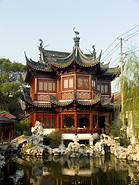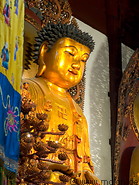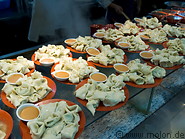
Shanghai is one of the highly popular tourist destinations of the world and Shanghai tourism is a booming industry. Each year, tourists come to this wonderful metropolis and have a blast during their vacations. The traditional yet contemporary aspect of the city has a distinct characteristic of its own. There are numerous tourist attractions in Shanghai. Visitors can take sightseeing tours, explore the well-known places of the city and taste the unique Chinese flavor, which is evident in almost every corner of Shanghai. Numerous world-class luxurious hotels, star hotels and budget hotels accommodate the tourists that pour in here. The famous Chinese hospitality makes your tour all the more enjoyable.
Shanghai is one of the highly popular tourist destinations of the world and Shanghai tourism is a booming industry. Here, we give you a brief idea about the Shanghai Tourist Information Center. Each year, tourists come to this wonderful metropolis and have a blast during their vacations. Shanghai Municipal Tourist Information Center has been set up by the Shanghai Municipal Tourism Administrative Commission, in a joint effort with the various communications departments and the governments of the county people. Shanghai Tourist Information Center is a special institution and consultation service. The Tourist Information and Service Center of Shanghai is entrusted with the responsibility to perform some of the basic functions like publicity of Shanghai as a tourist hotspot and promoting the newly developed scenic areas in Shanghai.
Shanghai Tourist Information Center helps you with different inquiries by offering on-the-spot consultation services, reference literature and multimedia based tourist maps. Shanghai Tourist Information and Service Center also offers service for individual tourists by booking tickets for special tourist buses, long-distance express buses, ships, trains and airplanes. They will even make booking arrangements in tourist hotels in Shanghai. Besides, services like rescue assistance, handling of complaints, display of tourist souvenirs and so on.
Shanghai Population
Shanghai, the eighth largest city of the world is also the largest city in China. China is the most populous nation in the world. Shanghai, one of the major cities in China, is also home to a large number of people. According to a recent sample survey, the population graph shows that Shanghai population has surpassed the limit of 20 million. Since the People's Republic was founded 1949, the demographic pattern of Shanghai has gone through five major phases. The phases can be divided as:
The booming period (1949 – 1959)
The period of gradual increase (1960 – 1968)
The period of shrinking (1969 - 1977)
The period of increase (1978 – 1990)
The period of low increase (1991 – present)
Official figures suggest that by the end of 2002, the city of Shanghai was home to about 13.34 million people who are registered permanent residents. In addition to that, there are more than 3 million people who make the floating population. If one goes by the population census conducted in 2000, population of Shanghai experienced a natural increment -1.9 per 1,000. The rapid urbanization and ever increasing metropolitan regions has resulted a huge increase in the urban population. In the year 2000, the urban population of Shanghai leaped to 14.78 million, which accounted for 88.31percent of the total population.
 |  |  |  |
Shanghai Accommodation
Shanghai is one of the highly popular tourist destinations of the world and tourism in Shanghai is a booming industry. Here, we give you a brief idea about the Shanghai accommodation. Each year, tourists come to this wonderful metropolis and have a blast during their vacations. If you plan to take a tour of the famous city of Shanghai, you will always look for some accommodation which is cozy, comfortable and offers the facilities and services that are convenient enough to make your vacation in Shanghai all the more enjoyable. Numerous world-class luxurious hotels, star hotels and budget hotels accommodate the tourists that pour in here. The famous Chinese hospitality makes your tour a thing to cherish forever.
Shanghai is home to many luxury hotels, which are right up there with the very best in the hospitality industry. There are internationally acclaimed and reputed hotels such as the Park Hotel, JW Marriott, JC Mandarin, Grand Hyatt, Four Seasons, Ritz Portman and many others. As one can expect, services of these upper crest hotels have a price. But you don't have to worry if your budget doesn't allow you the luxury of the highest quality. There are numerous cheap Shanghai accommodations, hotels and budget hotel chains like Super Group, 168 Motel etc. who are dedicated to serve you without compromising much on the quality and comfort.
Geography of Shanghai.
The city experiences all the four seasons. Usually, spring arrives in March, summer in June, autumn starts in September and winter in December. The months of July and August are the hottest, recording an average high of 32 degrees. Summers experience torrential rain quite frequently. In spite of being hot and humid, summer is the peak season for tourism. The most beautiful season in Shanghai is the spring, though it receives frequent spells of rain, and the temperature also varies. Often during a year, the city experiences a few spells of typhoons. The cyclone inflicts a considerable amount of damage to the city.
Shanghai Jewish History
- Jewish life in Shanghai dates back to the beginning of the 19th century. They made an important cultural impact on the economic and development of Shanghai. During the World War II, the city saved an estimated 30,000 Jewish lives by welcoming refugees fleeing the Nazis.
- The First Wave of Jewish Migration to Shanghai (1843-1920): Mainly doing business in Shanghai.
- The Second Wave of Jewish Migration to Shanghai (1920-1937)
- The migration of thousands of Russian Jews first move to Northeast China, and later to Shanghai. these Jews played an active and important role in the development of Shanghai by taking part in real estate and the stock exchange,. - The Third Wave (1938-1952, during World War II)
- From 1938 on, some 20,000 Jewish refugees from Germany and Austria escaped to Shanghai, the only place in the world that did not require a visa to enter. Between 1939 and 1940, approximately 1,000 Polish Jews escaped to Shanghai. By the end of the war, Shanghai was home to approximately 24,000 Jews. - After the Communist revolution in 1949, the Jewish population largely left the country.
- The Jewish Community of Shanghai now has 250 Jews, living and working in the city from 12 different countries .The population growing by 30% annually. Thousands of Jewish visitors pass through the city on a regular basis, including businesspeople and tourists.
Jewish Sites in Shanghai - Ohel Rechel Synagogue
- Ohel Rachel Synagogue, Shanghai Jewish School
- This is the most important Jewish Community building still standing today and remains the most significant symbol of the crucial Jewish role in Shanghai's history. It was built in 1920, and was used from 1920 to 1952.
- The main entrance is located at Shaanxi North Road. The site hosted the Shanghai Jewish School.
- Ohel Rachel was the first of seven synagogues built in Shanghai, and only one of two still standing Today. The other, the Ohel Moishe Synagogue located in Hong Kou district.
- The Ohel Rachel Synagogue has been renovated and restored in time for the Shanghai 2010 Expo, and is now open for weekly Shabbat services and Shabbat meals! The synagogue is beautiful and it is a must-do for any Jewish visitor

The Shanghai French Concession, also known as French town, was a former foreign concession in Shanghai during the period of 1849 to 1946. It includes the area of Luwan and Xuhui District, which has always been Shanghai's most charming district.

Expo 2010 Shanghai China is a great event to explore the full potential of urban life in the 21st century and a significant period in urban evolution. Fifty-five percent of the world population is expected to live in cities by 2010. The prospect of future urban life, a subject of global interest, concerns all nations, developed or less developed, and their people. Being the first World Exposition on the theme of ‘city’, Exposition 2010 has attracted governments and people from across the world. It focuses on the theme “Better City, Better Life”. During its 184-days run, participants are displaying urban civilisation to the full extent, with a view to exchange their experiences of urban development, disseminate advanced notions on cities and explore new approaches to human habitat, lifestyle and working conditions in the new century. The stage is set to give opportunities to learn how to create an eco-friendly society and maintain the sustainable development of human beings.
The Shanghai Expo is a grand international gathering. On the one hand, it has attracted 246 nations and international organisations to take part in the exhibition and is on course to attract 70 million visitors from home and abroad, thus breaking the record set by the Osaka Expo in 1970 with 64 million visitors, ensuring the widest possible participation in the history of the World Expositions. On the other hand, Expo 2010 Shanghai has put China in a global perspective and has done its best to encourage participation, gain understanding and support of various countries and peoples, to turn the event into a happy reunion of people from all over the world.
Besides, Expo 2010 Shanghai offers a wonderful opportunity for cross-culture dialogues. Before the conclusion of the Exposition, a “Shanghai Declaration” will be issued. This declaration, hopefully a milestone in the history of the World Expositions, will symbolise the insights to be offered by the participants and embody people’s ideas for future cooperation and development and extensive common aspirations, thereby leaving a rich legacy of urban development to people throughout the world.
The Chinese Government has gone to great lengths to make the Shanghai Expo a special event that carries on traditions and opens a new vista into the future. The motto is: “Keeping in mind the next 60 years’ development while preparing for the six months’ Exposition.” China counts on the continuing attention, support and participation of all the peace-loving countries.
Today just after two and a half months since the opening, the Shanghai Expo is in full swing. One Commissioner General summed up by saying: “It’s like nothing I have ever seen before, every country on the face of the earth is here, this is an epic event, the site alone is twice the size of Monaco. Out of the 70 million people expected to attend over the next six months, 95 percent will be Chinese, it will be their first opportunity to get an impression of our country, our people, culture and places.”
The Culture of Shanghai
The rise of modern Shanghai in just one hundred years is a miracle in the history of Chinese development. A city is alive when it is full of culture and hai pai (mainly referring to Shanghai) culture is at the root of Shanghai's energy and charm.
Before 1843, Shanghai culture mainly came from the ancient kingdoms of Wu and Yue, from Jiangsu and Zhejiang Provinces. After 1843, when western civilization came to China through Shanghai for the first time, Shanghai developed rapidly into the national commercial and economic centre. Thus hai pai culture, the combination of Chinese and Western cultures, gradually formed.
The term hai pai (literally 'Shanghai style') was coined by a group of Beijing writers in 1920 to criticize some Shanghai scholars and styles of writing for their admiration of money and western cultures. Hai pai is rebellious while its opposite jing pai, or 'Beijing style', is traditional. They represent two kinds of different Chinese cultures. The famous author Cao Juren wrote in the article Jing Pai and Hai Pai in the 1920s that, "jing pai is like a fair lady, while hai pai is like a modern babe."
The unconventional 'Yuanyang Hudie Pai,' Mandarin Duck and Butterfly Genre in literature
A group of scholars in the Shanghai art and literary circles spontaneously organized 'yuanyang hudie pai', the Mandarin Duck and Butterfly genre of popular romance in the early 1900s. This style of writer, such as Zhang Henshui and Qin Shou'ou, entertained the audience with amusing and light literature.

No comments:
Post a Comment